Blood Compatibility of Sulfonated Cladophora Nanocellulose Beads
Abstract
:1. Introduction
2. Results and Discussion
3. Materials and Methods
3.1. Chemicals
3.2. Preparation of Sulfonated Cladophora Nanocellulose Beads
3.3. Materials Characterization
3.3.1. Specific Surface Area (SSA) and Pore Size Distribution Analysis
3.3.2. Particle Size Measurements
3.3.3. Conductometric Titration
3.3.4. ζ-Potential Measurements
3.3.5. Scanning Electron Microscopy (SEM)
3.4. Blood Compatibility Studies
3.4.1. Heparinization
3.4.2. Blood Sampling
3.4.3. Loop Model
3.4.4. Enzyme-Linked Immunosorbent Assays (ELISAs) for Coagulation and Complement System Activation Markers
TAT Complexes
C3a
sC5b-9
3.4.5. Hemolysis
3.5. Statistical Analysis
4. Conclusions
Supplementary Materials
Acknowledgments
Author Contributions
Conflicts of Interest
References
- Ruan, C.; Strømme, M.; Lindh, J. A green and simple method for preparation of an efficient palladium adsorbent based on cysteine functionalized 2,3-dialdehyde cellulose. Cellulose 2016, 23, 2627–2638. [Google Scholar] [CrossRef]
- Ruan, C.-Q.; Strømme, M.; Lindh, J. Preparation of porous 2,3-dialdehyde cellulose beads crosslinked with chitosan and their application in adsorption of Congo red dye. Carbohydr. Polym. 2018, 181, 200–207. [Google Scholar] [CrossRef] [PubMed]
- Jin, L.; Li, W.; Xu, Q.; Sun, Q. Amino-functionalized nanocrystalline cellulose as an adsorbent for anionic dyes. Cellulose 2015, 22, 2443–2456. [Google Scholar] [CrossRef]
- Fang, H.; Wei, J.; Yu, Y. In vivo studies of endotoxin removal by lysine-cellulose adsorbents. Biomaterials 2004, 25, 5433–5440. [Google Scholar] [CrossRef] [PubMed]
- Kai, Y.; Hamada, J.I.; Morioka, M.; Yano, S.; Nakamura, H.; Makino, K.; Mizuno, T.; Takeshima, H.; Kuratsu, J.I. Preoperative cellulose porous beads for therapeutic embolization of meningioma: Provocation test and technical considerations. Neuroradiology 2007, 49, 437–443. [Google Scholar] [CrossRef] [PubMed]
- Hamada, J.; Kai, Y.; Nagahiro, S.; Hashimoto, N.; Iwata, H.; Ushio, Y. Embolization with cellulose porous beads, II: Clinical trial. AJNR. Am. J. Neuroradiol. 2000, 17, 1901–1906. [Google Scholar]
- Kutsuki, H. β2-Microglobulin-selective direct hemoperfusion column for the treatment of dialysis-related amyloidosis. Biochim. Biophys. Acta Proteins Proteom. 2005, 1753, 141–145. [Google Scholar] [CrossRef] [PubMed]
- Gorbet, M.B.; Sefton, M.V. Biomaterial-associated thrombosis: Roles of coagulation factors, complement, platelets and leukocytes. Biomaterials 2004, 25, 5681–5703. [Google Scholar] [CrossRef] [PubMed]
- Ekdahl, K.N.; Lambris, J.D.; Elwing, H.; Ricklin, D.; Nilsson, P.H.; Teramura, Y.; Nicholls, I.A.; Nilsson, B. Innate immunity activation on biomaterial surfaces: A mechanistic model and coping strategies. Adv. Drug Deliv. Rev. 2011, 63, 1042–1050. [Google Scholar] [CrossRef] [PubMed]
- Junqueira, D.R.G.; Carvalho, M.D.G.; Perini, E. Heparin-induced thrombocytopenia: A review of concepts regarding a dangerous adverse drug reaction. Rev. Assoc. Méd. Bras. 2013, 59, 161–166. [Google Scholar] [CrossRef] [PubMed]
- De Mel, A.; Cousins, B.G.; Seifalian, A.M. Surface modification of biomaterials: A quest for blood compatibility. Int. J. Biomater. 2012, 2012, 1–8. [Google Scholar] [CrossRef] [PubMed]
- Ran, F.; Nie, S.; Li, J.; Su, B.; Sun, S.; Zhao, C. Heparin-like macromolecules for the modification of anticoagulant biomaterials. Macromol. Biosci. 2012, 12, 116–125. [Google Scholar] [CrossRef] [PubMed]
- Larm, O.; Larsson, R.; Olsson, P. A new non-thrombogenic surface prepared by selective covalent binding of heparin via a modified reducing terminal residue. Biomater. Med. Devices Artif. Organs 1983, 11, 161–173. [Google Scholar] [CrossRef] [PubMed]
- Sakiyama-Elbert, S.E. Incorporation of heparin into biomaterials. Acta Biomater. 2014, 10, 1581–1587. [Google Scholar] [CrossRef] [PubMed]
- Kanmangne, F.M.; Labsme, D.; Serne, H.; Jozefowicz, M. Heparin-like activity of insoluble sulphonated polystyrene resins. Biomaterials 1985, 6, 297–302. [Google Scholar] [CrossRef]
- Silver, J.H.; Hart, A.P.; Williams, E.C.; Cooper, S.L.; Charef, S.; Labarre, D.; Jozefowicz, M. Anticoagulant effects of sulphonated polyurethanes. Biomaterials 1992, 13, 339–344. [Google Scholar] [CrossRef]
- Okkema, A.Z.; Cooper, S.L. Effect of carboxylate and/or sulphonate ion incorporation on the physical and blood-contacting properties of a polyetherurethane. Biomaterials 1991, 12, 668–676. [Google Scholar] [CrossRef]
- Rocha, I.; Ferraz, N.; Mihranyan, A.; Strømme, M.; Lindh, J. Sulfonated nanocellulose beads as potential immunosorbents. Cellulose 2018. [Google Scholar] [CrossRef]
- Mihranyan, A.; Edsman, K.; Strømme, M. Rheological properties of cellulose hydrogels prepared from Cladophora cellulose powder. Food Hydrocoll. 2007, 21, 267–272. [Google Scholar] [CrossRef]
- Mihranyan, A. Cellulose from Cladophorales green algae: From environmental problem to high-tech composite materials. J. Appl. Polym. Sci. 2010, 119, 2449–2460. [Google Scholar] [CrossRef]
- Gustafsson, S.; Lordat, P.; Hanrieder, T.; Asper, M.; Schaefer, O.; Mihranyan, A. Mille-feuille paper: A novel type of filter architecture for advanced virus separation applications. Mater. Horiz. 2016, 3, 320–327. [Google Scholar] [CrossRef]
- Metreveli, G.; Wågberg, L.; Emmoth, E.; Belák, S.; Strømme, M.; Mihranyan, A. A size-exclusion nanocellulose filter paper for virus removal. Adv. Healthc. Mater. 2014, 3, 1546–1550. [Google Scholar] [CrossRef] [PubMed]
- Asper, M.; Hanrieder, T.; Quellmalz, A.; Mihranyan, A. Removal of xenotropic murine leukemia virus by nanocellulose based filter paper. Biologicals 2015, 43, 452–456. [Google Scholar] [CrossRef] [PubMed]
- Ferraz, N.; Mihranyan, A. Is there a future for electrochemically assisted hemodialysis? Focus on the application of polypyrrole-nanocellulose composites. Nanomedicine 2014, 9, 1095–1110. [Google Scholar] [CrossRef] [PubMed]
- Ferraz, N.; Strømme, M.; Fellström, B.; Pradhan, S.; Nyholm, L.; Mihranyan, A. In vitro and in vivo toxicity of rinsed and aged nanocellulose-polypyrrole composites. J. Biomed. Mater. Res. A 2012, 100, 2128–2138. [Google Scholar] [CrossRef] [PubMed]
- Ferraz, N.; Carlsson, D.O.; Hong, J.; Larsson, R.; Fellström, B.; Nyholm, L.; Strømme, M.; Mihranyan, A. Haemocompatibility and ion exchange capability of nanocellulose polypyrrole membranes intended for blood purification. J. R. Soc. Interface 2012, 9, 1943–1955. [Google Scholar] [CrossRef] [PubMed]
- Xu, C.; Carlsson, D.O.; Mihranyan, A. Feasibility of using DNA-immobilized nanocellulose-based immunoadsorbent for systemic lupus erythematosus plasmapheresis. Colloids Surf. B Biointerfaces 2016, 143, 1–6. [Google Scholar] [CrossRef] [PubMed]
- Mihranyan, A.; Andersson, S.B.; Ek, R. Sorption of nicotine to cellulose powders. Eur. J. Pharm. Sci. 2004, 22, 279–286. [Google Scholar] [CrossRef] [PubMed]
- Carlsson, D.O.; Lindh, J.; Nyholm, L.; Strømme, M.; Mihranyan, A. Cooxidant-free TEMPO-mediated oxidation of highly crystalline nanocellulose in water. RSC Adv. 2014, 4, 52289–52298. [Google Scholar] [CrossRef]
- Tamada, Y. Sulfation of silk fibroin by chlorosulfonic acid and the anticoagulant activity. Biomaterials 2004, 25, 377–383. [Google Scholar] [CrossRef]
- Groth, T.; Wagenknecht, W. Anticoagulant potential of regioselective derivatized cellulose. Biomaterials 2001, 22, 2719–2729. [Google Scholar] [CrossRef]
- Maas, N.C.; Gracher, A.H.P.; Sassaki, G.L.; Gorin, P.A.J.; Iacomini, M.; Cipriani, T.R. Sulfation pattern of citrus pectin and its carboxy-reduced derivatives: Influence on anticoagulant and antithrombotic effects. Carbohydr. Polym. 2012, 89, 1081–1087. [Google Scholar] [CrossRef] [PubMed]
- Han, D.K.; Lee, N.Y.; Park, K.D.; Kim, Y.H.; Ik Cho, H.; Min, B.G. Heparin-like anticoagulant activity of sulphonated poly(ethylene oxide) and sulphonated poly(ethylene oxide)-grafted polyurethane. Biomaterials 1995, 16, 467–471. [Google Scholar] [CrossRef]
- Tamada, Y.; Murata, M.; Hayashi, T.; Goto, K. Anticoagulant mechanism of sulfonated polyisoprenes. Biomaterials 2002, 23, 1375–1382. [Google Scholar] [CrossRef]
- Xu, L.C.; Bauer, J.W.; Siedlecki, C.A. Proteins, platelets, and blood coagulation at biomaterial interfaces. Colloids Surf. B Biointerfaces 2014, 124, 49–68. [Google Scholar] [CrossRef] [PubMed]
- Sperling, C.; Fischer, M.; Maitz, M.F.; Werner, C. Blood coagulation on biomaterials requires the combination of distinct activation processes. Biomaterials 2009, 30, 4447–4456. [Google Scholar] [CrossRef] [PubMed]
- Brash, J.L. Exploiting the current paradigm of blood-material interactions for the rational design of blood-compatible materials. J. Biomater. Sci. Polym. Ed. 2000, 11, 1135–1146. [Google Scholar] [CrossRef] [PubMed]
- Horbett, T.A. Chapter 13 Principles underlying the role of adsorbed plasma proteins in blood interactions with foreign materials. Cardiovasc. Pathol. 1993, 2, 137–148. [Google Scholar] [CrossRef]
- Ferraz, N.; Hong, J.; Karlsson Ott, M. Procoagulant behavior and platelet microparticle generation on nanoporous alumina. J. Biomater. Appl. 2010, 24, 675–692. [Google Scholar] [CrossRef] [PubMed]
- Geer, C.B.; Rus, I.A.; Lord, S.T.; Schoenfisch, M.H. Surface-dependent fibrinopeptide A accessibility to thrombin. Acta Biomater. 2007, 3, 663–668. [Google Scholar] [CrossRef] [PubMed]
- Nilsson, B.; Svensson, K.E.; Inganäs, M.; Nilsson, U.R. A simplified assay for the detection of C3a in human plasma employing a monoclonal antibody raised against denatured C3. J. Immunol. Methods 1988, 107, 281–287. [Google Scholar] [CrossRef]
- Mollnes, T.E.; Lea, T.; Harboe, M. Quantification of the terminal complement complex in human plasma by an enzyme-linked immunosorbent assay based on monoclonal antibodies against a neoantigen of the complex. Scand. J. Immunol. 1985, 22, 197–202. [Google Scholar] [CrossRef] [PubMed]
- Deppisch, R.; Göhl, H.; Smeby, L. Microdomain structure of polymeric surfaces—Potential for improving blood treatment procedures. Nephrol. Dial. Transplant. 1998, 13, 1354–1359. [Google Scholar] [CrossRef] [PubMed]
- Nilsson, B.; Ekdahl, K.N.; Mollnes, T.E.; Lambris, J.D. The role of complement in biomaterial-induced inflammation. Mol. Immunol. 2007, 44, 82–94. [Google Scholar] [CrossRef] [PubMed]
- Gong, J.; Larsson, R.; Ekdahl, K.N.; Mollnes, T.E.; Nilsson, U.; Nilsson, B. Tubing loops as a model for cardiopulmonary bypass circuits: Both the biomaterial and the blood-gas phase interfaces induce complement activation in an in vivo model. J. Clin. Immunol. 1996, 16, 222–229. [Google Scholar] [CrossRef] [PubMed]
- Lappegård, K.T.; Fung, M.; Bergseth, G.; Riesenfeld, J.; Lambris, J.D.; Videm, V.; Mollnes, T.E. Effect of complement inhibition and heparin coating on artificial surface-induced leukocyte and platelet activation. Ann. Thorac. Surg. 2004, 77, 932–941. [Google Scholar] [CrossRef]
- Moen, O.; Høgåsen, K.; Fosse, E.; Dregelid, E.; Brockmeier, V.; Venge, P.; Harboe, M.; Mollnes, T.E. Attenuation of changes in leukocyte surface markers and complement activation with heparin-coated cardiopulmonary bypass. Ann. Thorac. Surg. 1997, 63, 105–111. [Google Scholar] [CrossRef]
- Paul, D.; Malsch, G.; Bossin, E.; Wiese, F.; Thomaneck, U.; Brown, G.S.; Werner, H.; Falkenhagen, D. Chemical modification of cellulosic membranes and their blood compatibility. Artif. Organs 2008, 14, 122–125. [Google Scholar] [CrossRef]
- Hakim, R.M. Chapter 18 Complement activation by biomaterials. Cardiovasc. Pathol. 1993, 2, 187–197. [Google Scholar] [CrossRef]
- Lindh, J.; Carlsson, D.O.; Strømme, M.; Mihranyan, A. Convenient one-pot formation of 2,3-dialdehyde cellulose beads via periodate oxidation of cellulose in water. Biomacromolecules 2014, 15, 1928–1932. [Google Scholar] [CrossRef] [PubMed]
- Brunauer, S.; Emmett, P.H.; Teller, E. Adsorption of gases in multimolecular layers. J. Am. Chem. Soc. 1938, 60, 309–319. [Google Scholar] [CrossRef]
- Landers, J.; Gor, G.Y.; Neimark, A.V. Colloids and Surfaces A: Physicochemical and engineering aspects density functional theory methods for characterization of porous materials. Colloids Surf. A Physicochem. Eng. Asp. 2013, 437, 3–32. [Google Scholar] [CrossRef]
- Beck, S.; Méthot, M.; Bouchard, J.; Me, M.; Bouchard, J. General procedure for determining cellulose nanocrystal sulfate half-ester content by conductometric titration. Cellulose 2015, 22, 101–116. [Google Scholar] [CrossRef]
- Ekstrand-Hammarström, B.; Hong, J.; Davoodpour, P.; Sandholm, K.; Ekdahl, K.N.; Bucht, A.; Nilsson, B. TiO2 nanoparticles tested in a novel screening whole human blood model of toxicity trigger adverse activation of the kallikrein system at low concentrations. Biomaterials 2015, 51, 58–68. [Google Scholar] [CrossRef] [PubMed]
- Hadnagy, W.; Marsetz, B.; Idel, H. Hemolytic activity of crystalline silica—Separated erythrocytes versus whole blood. Int. J. Hyg. Environ. Health 2003, 206, 103–107. [Google Scholar] [CrossRef] [PubMed]

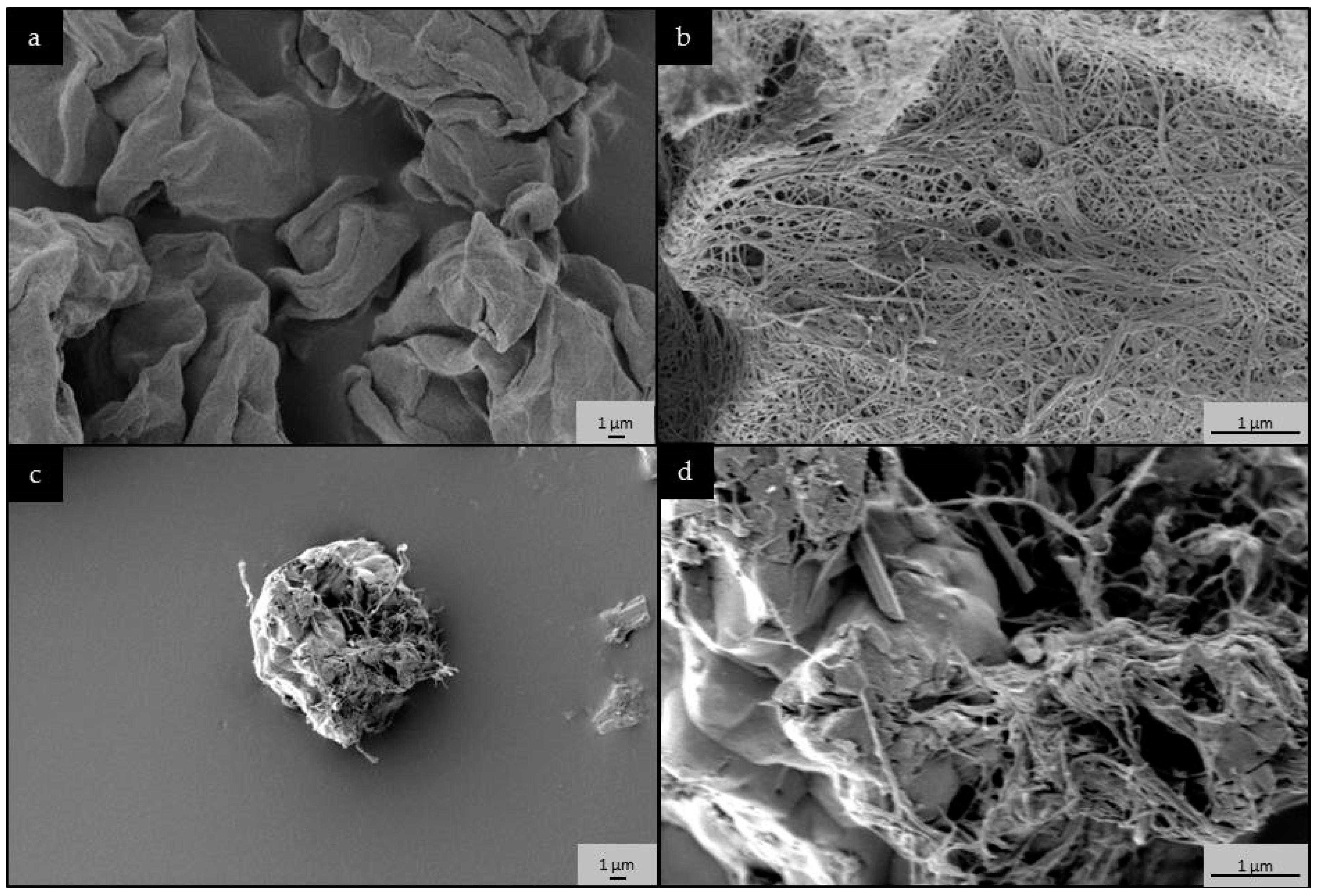
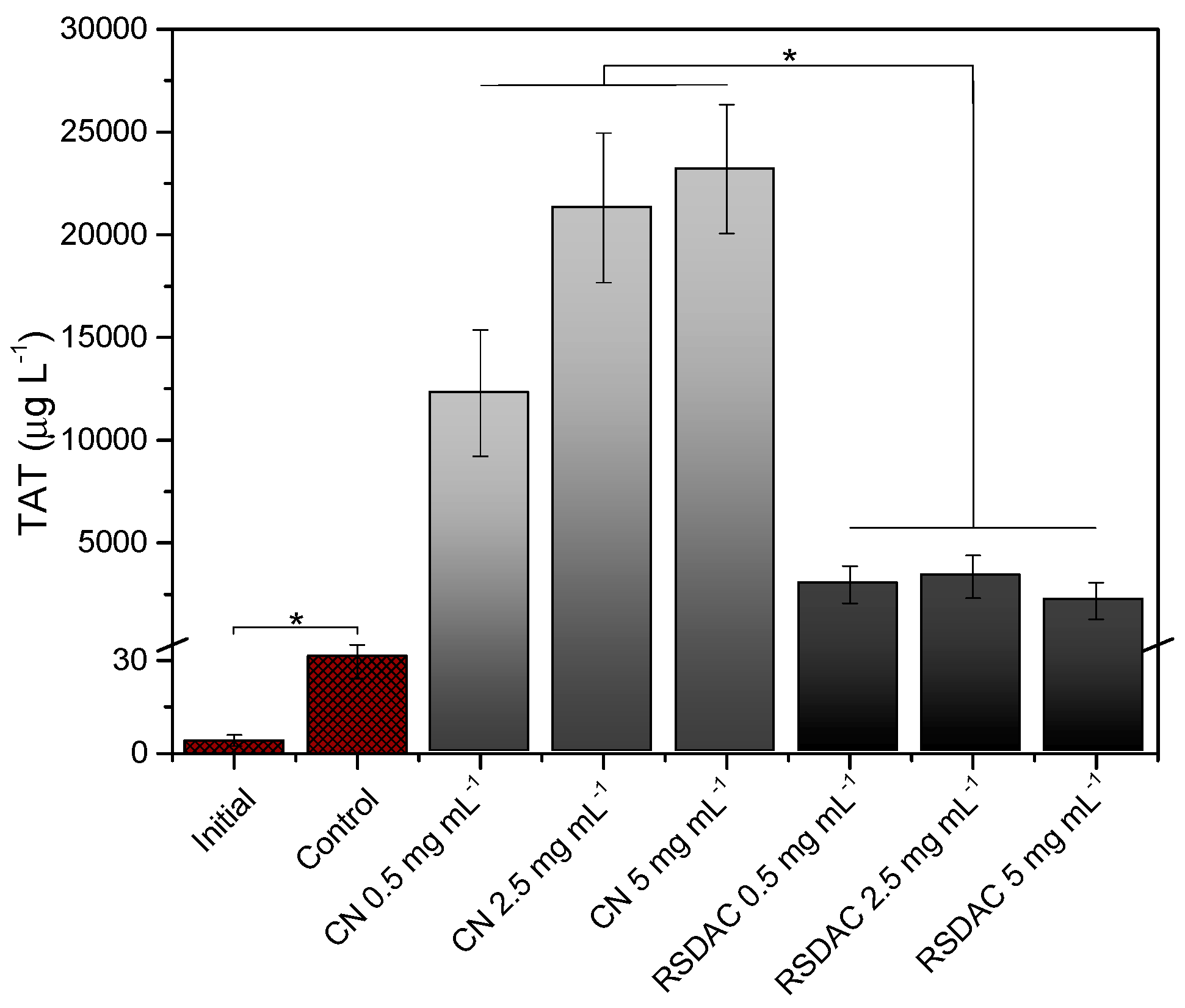
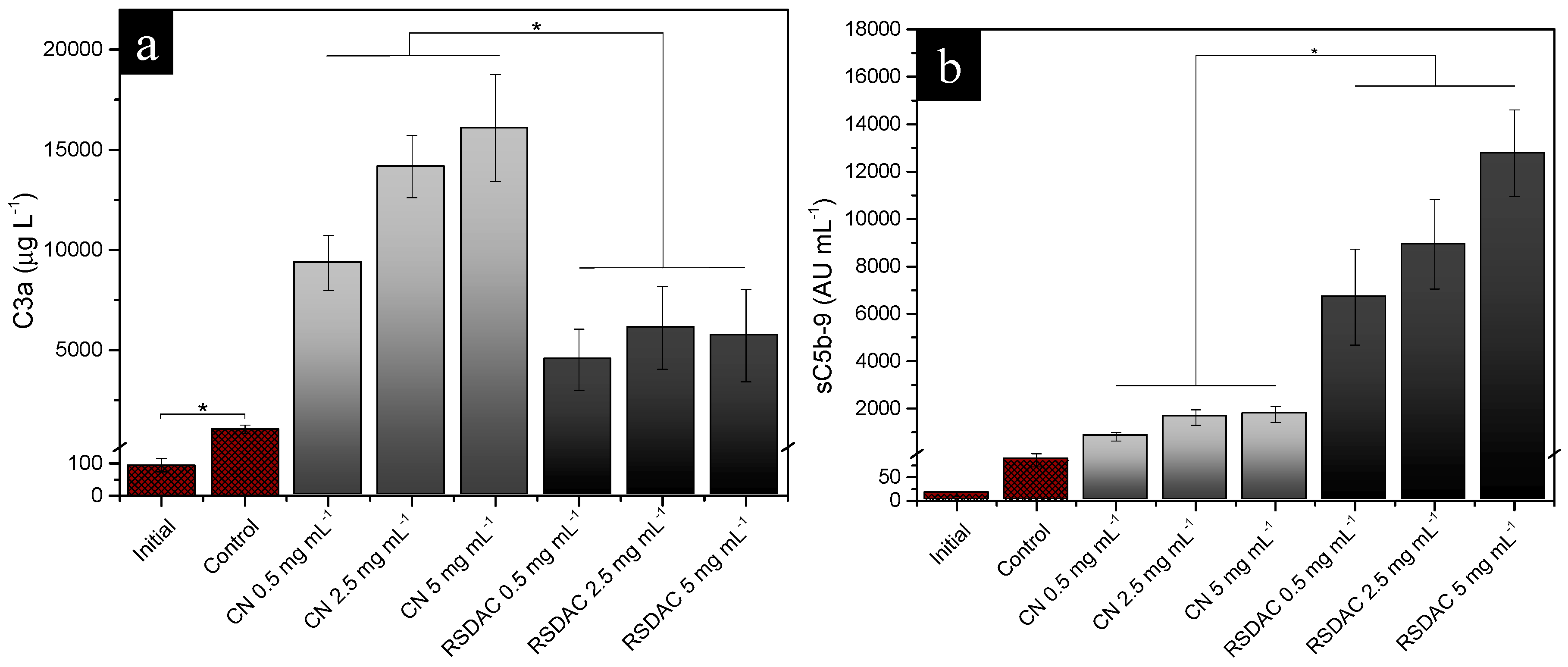
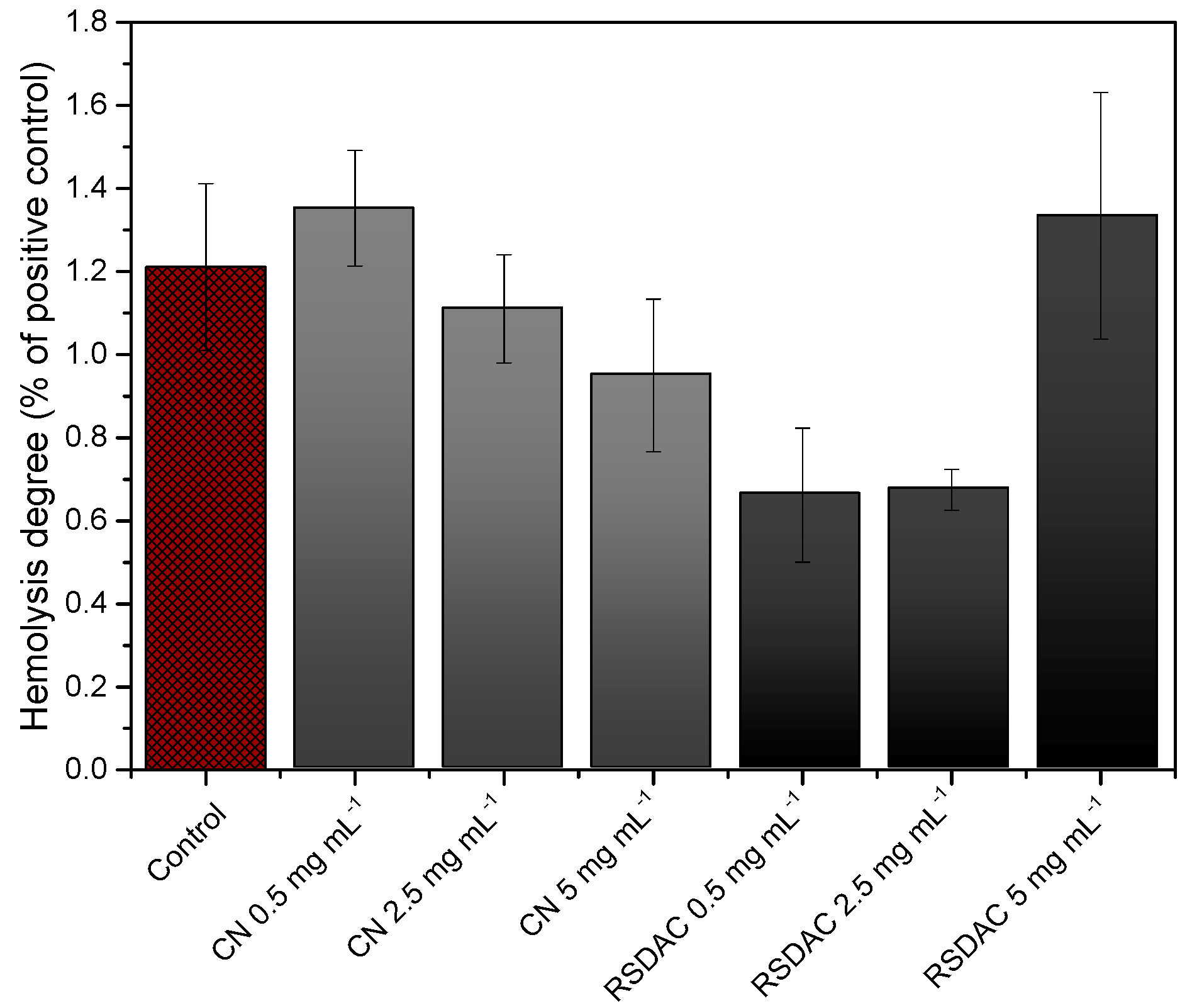
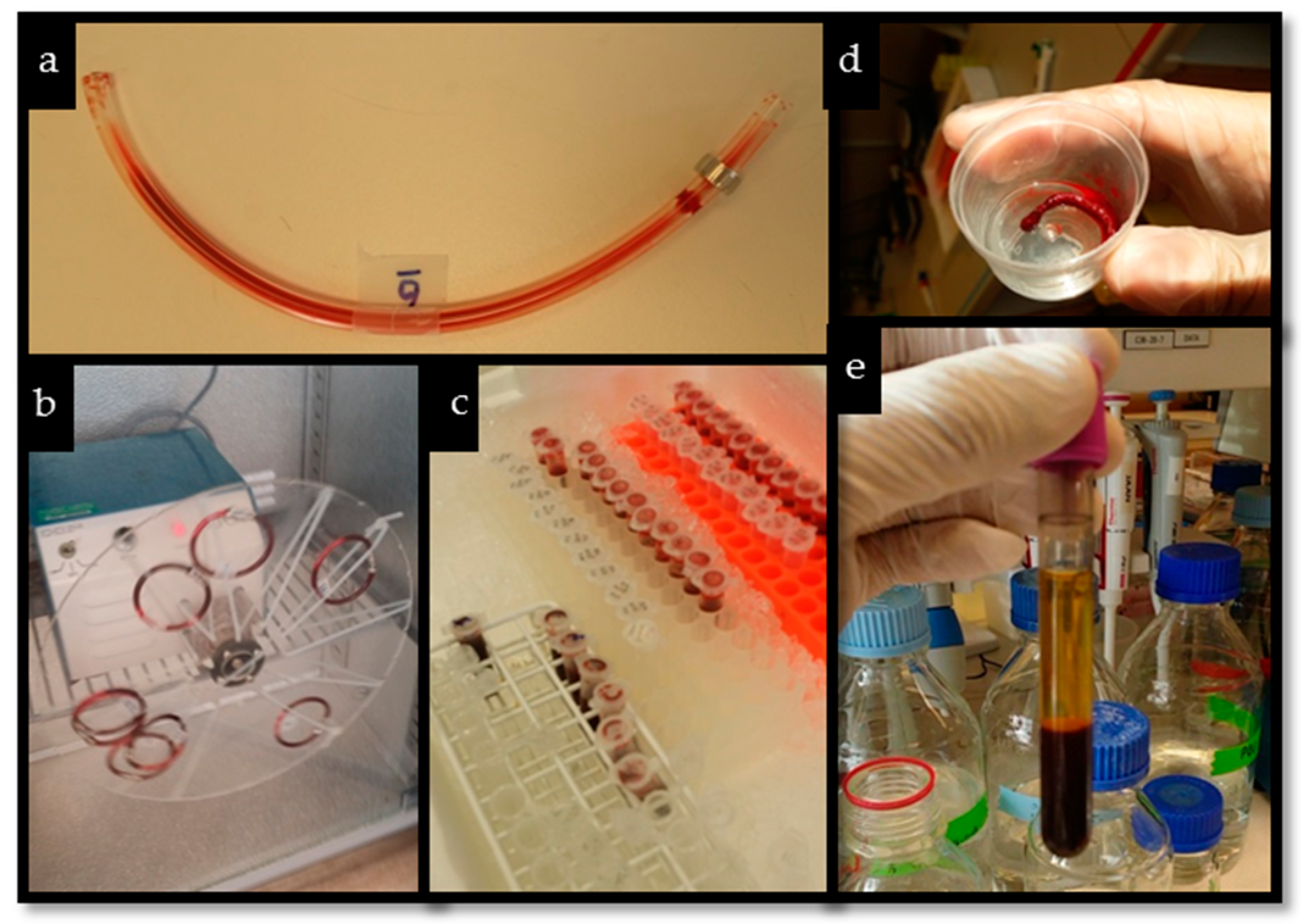
| Physicochemical Properties | Cladophora Nanocellulose | RSDAC |
|---|---|---|
| Surface charged groups (μmol g−1) | 32 ± 2 a | 486 ± 5 b |
| ζ-potential at pH 6.5 (mV) | −8 ± 3 | −25 ± 3 |
| Specific surface area (m2 g−1) | 96 | 90 |
| Total pore volume (cm3 g−1) | 0.44 | 0.20 |
| Pore size distribution mode (nm) | 13 | 40 |
| Beads size (µm) | - | 17 ± 5 |
© 2018 by the authors. Licensee MDPI, Basel, Switzerland. This article is an open access article distributed under the terms and conditions of the Creative Commons Attribution (CC BY) license (http://creativecommons.org/licenses/by/4.0/).
Share and Cite
Rocha, I.; Lindh, J.; Hong, J.; Strømme, M.; Mihranyan, A.; Ferraz, N. Blood Compatibility of Sulfonated Cladophora Nanocellulose Beads. Molecules 2018, 23, 601. https://doi.org/10.3390/molecules23030601
Rocha I, Lindh J, Hong J, Strømme M, Mihranyan A, Ferraz N. Blood Compatibility of Sulfonated Cladophora Nanocellulose Beads. Molecules. 2018; 23(3):601. https://doi.org/10.3390/molecules23030601
Chicago/Turabian StyleRocha, Igor, Jonas Lindh, Jaan Hong, Maria Strømme, Albert Mihranyan, and Natalia Ferraz. 2018. "Blood Compatibility of Sulfonated Cladophora Nanocellulose Beads" Molecules 23, no. 3: 601. https://doi.org/10.3390/molecules23030601






